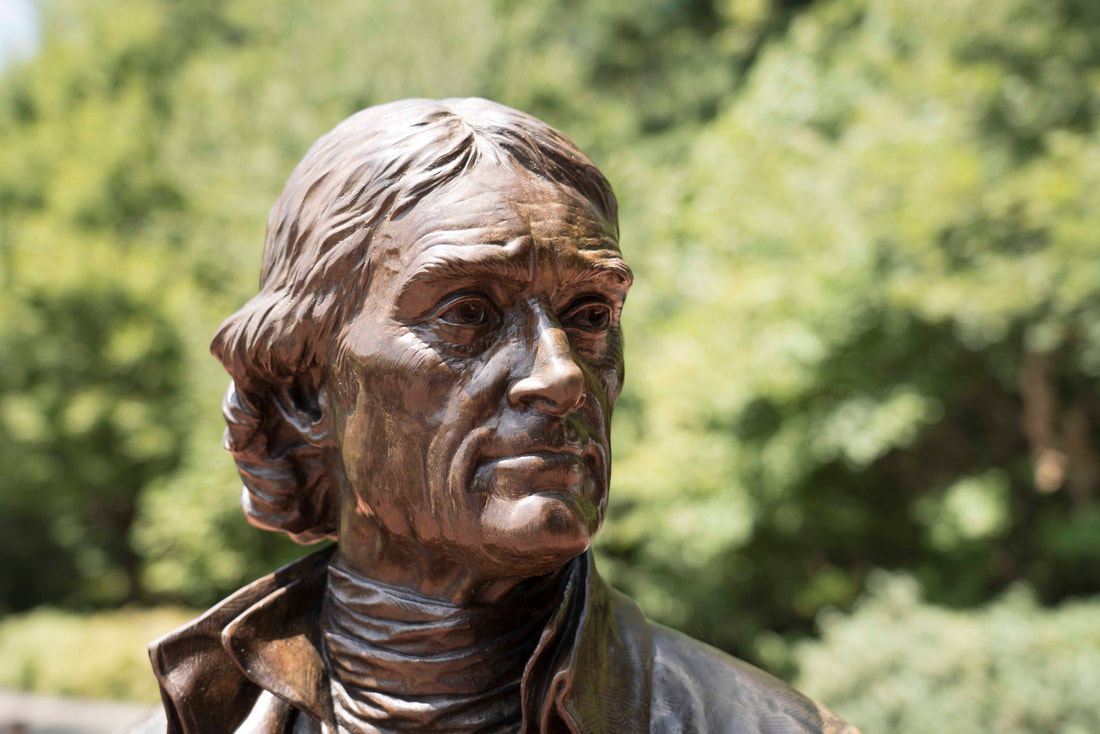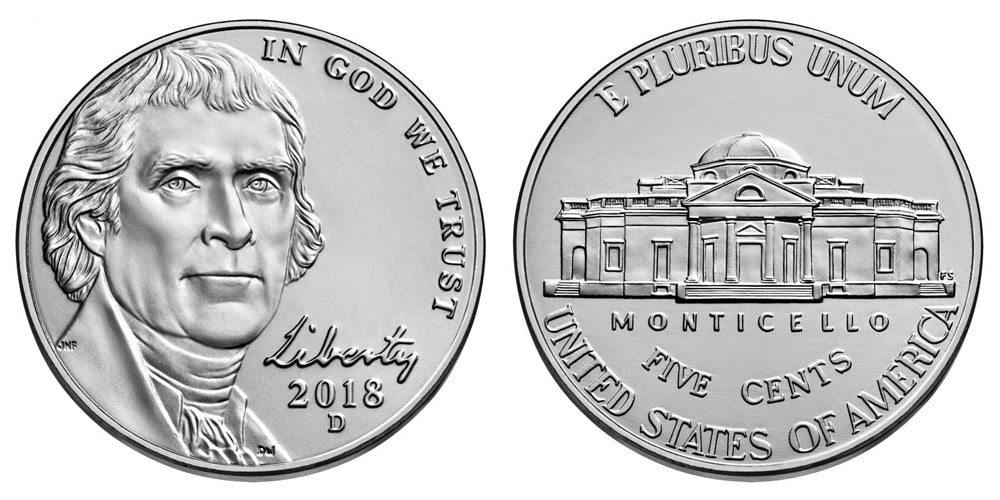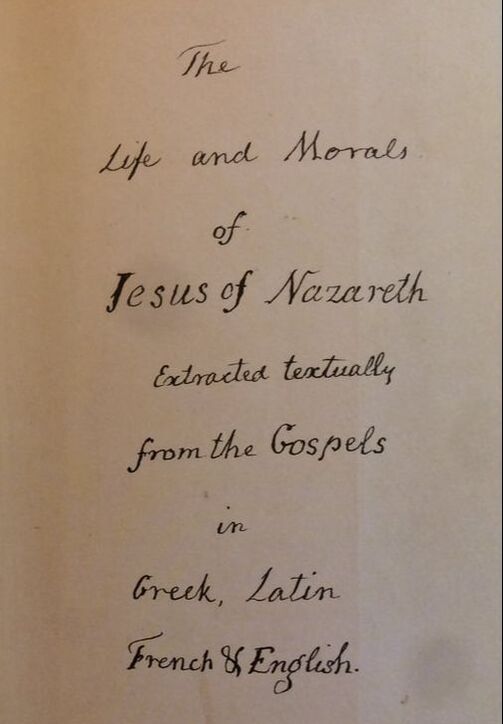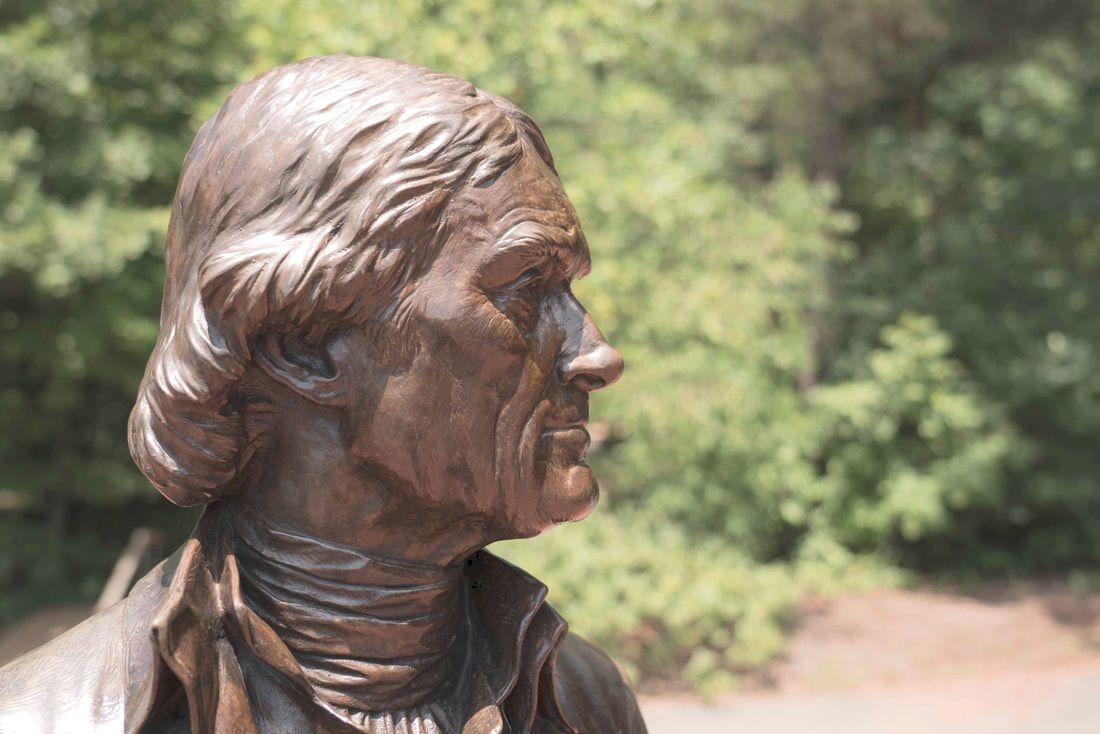|
Yes, I know. It is not an inspired pun. But, stay with me as we review the life of an American patriot and founding father and raise a somewhat surprising monetary question. You probably recognize our Founding Father from the image above. It is a close up of a life-size bronze sculpture, completed in 2009, that greets you as you board the bus takes you up the hill to see Thomas Jefferson's mansion. Jefferson's Monticello home is famous for its architecture and furnishings as well as for being the home of the author of the Declaration of Independence, our third President, Ambassador to France, and author of Virginia's first law preserving religious freedom. It is visited by citizens from around the world. As President, Jefferson commissioned the Lewis and Clarke expedition and completed the Louisiana Purchase which instantly doubled the land mass of the United States. In retirement, he founded and designed the University of Virginia, watching over construction with a telescope from the elevated setting of Monticello. He was a man of accomplishment who nourished a personal library so significant that when the Library of Congress was torched during the War of 1812, his books were used to reestablish the Library's collection. Jefferson was curious, inventive and well read to an extent that rivaled Benjamin Franklin. His home at Monticello is full of innovation and reflections of his deep curiosity about the world. The front entryway is full of souvenirs from the Lewis and Clarke Expedition as well as an inventive clock that uses weights and gravity to keep track of hours and days. Jefferson was ambitious and could be ruthless, setting a low-bar standard in his successful Presidential campaign against Adams that survived unchallenged until recent times. He was also pragmatic and idealistic, as when he crafted the message for the Declaration of Independence and fought to limit church influence over the Virginia legislature. He was also a complicated man. He was not openly religious, believing a man's belief was a private matter. And yet, he committed in correspondence with his good friend Benjamin Rush, who thought Jefferson to be too secular for his own good, to commit his beliefs to writing at some time. It was near the end of his life that he took on the project, compiling in four languages what he called The Life and Morals of Jesus of Nazareth. To complete the task, he purchased six bibles that he cut into clippings and arranged into a private volume. That volume, commonly called the Jefferson Bible, now resides in the Smithsonian's collection and is available to the public in a richly authentic reproduction produced in 2011. The images above are from that reproduction. Jefferson lived in an extraordinary time. The impact of his actions in support of the American Revolution and in securing religious freedom through the separation of church and State are still felt today, almost 250 years later. But like many Southern landowners, he was also the owner and master of hundreds of enslaved people, it taking more than 150 slaves to keep his home and plantation operating at any one time. Most of the enslaved people lived near the fields and out of site from the Jefferson's home. Those who worked around the house, like Sally Hemings who also bore children attributed to Jefferson, lived nearby in structures like this reconstructed cabin. Jefferson purported to abhor the institution of slavery in his personal letters but did not extract himself from it. His home, his lifestyle and his ability to influence the greater world were inextricably tied to his participation in a system that extracted wealth from enslaved people. His plantation could not run profitably without enslaved people to work its fields. It was his world. One where he was a master over enslaved people with no power. One where a plantation that supported only six or eight free persons might require the forced labor of more than 150 enslaved people to operate. It was a world where so many people were enslaved that it required legislative approval to free a person from slavery. While he relied on slavery for his livelihood, Jefferson also designed his beloved Monticello to hide the institution and his reliance on it as much as he could. On his plantation, many features were included - like back hallways, underground corridors, and dumbwaiters - to keep the work of slaves out of sight. So, where am I going with this? Am I going to question whether Jefferson should be removed from the nickle because he owned slaves? No, I have a more modest question to consider. Thomas Jefferson was a statesman, an eloquent spokesperson for separation of church and State, and the author of a Declaration of Independence that has inspired millions over the centuries. But, he was also the owner of an unprofitable plantation that left him deep in debt when he died. And, as he freed only a few of the Heming children upon his death, almost all of his slaves remained enslaved after his death. Hundreds of them were rounded up and sold on the steps of Monticello to the highest bidder to pay off his debts. It must have been an anguishing time for the enslaved individuals and families who worked on the Monticello plantation. So when you next look at a nickle, you will see the great Jefferson and his architectural wonder of Monticello. But, when you look at Monticello you will also be looking at the steps where hundreds of enslaved people were sold. Does the nickle need a change? With all of Jefferson's accomplishments, would an image of the Declaration of Independence or a map of the Louisiana Purchase be more fitting for the reverse side of the coin? ---
All photos (except for the stock image nickle) and text are copyright Clinton Richardson. If you like these posts, please tell your friends about the Venture Moola blog at Readjanus.com. Want to plan your own safari? If so, feel free to check out the outfitter we used at Porini.com. And, feel free to share this blog. The more readers the better. Click here if you would like to get a weekly email that notifies you when we release new entries. Or, click in the side column to follow us on Facebook or Twitter. The venture moola blog comes to you from Atlanta, Georgia. Find it at readjanus.com. Copyright Clinton Richardson.
Comments are closed.
|
the blog
Travel, history, and business with original photos.
your hostClinton Richardson - author, photographer, business advisor, traveler. Categories
All
Archives
July 2023
Follow us on Facebook
|
Check out Ancient Selfies a 2017 International Book Awards Finalist in History and 2018 eLit Awards Gold Medal Winner and
Passports in his Underpants - A Planet Friendly Photo Safari a 2020 Readers' Favorite Winner in Nonfiction
Site Copyright 2024 by Clinton Richardson









 RSS Feed
RSS Feed